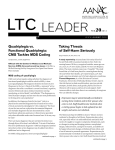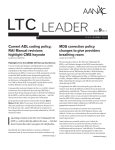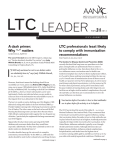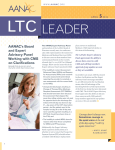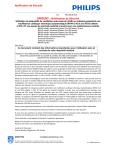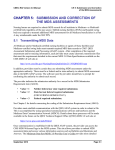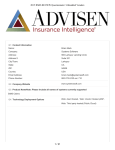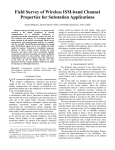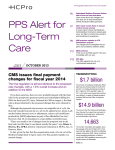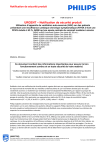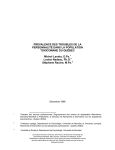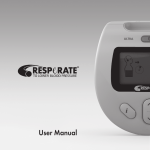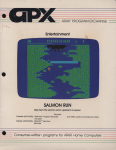Download LEADER - aanac
Transcript
LTC LEADER 15 nov 2012 w w w. a a n ac .o r g CMS Releases MDS 3.0 User’s Manual Update The latest MDS 3.0 RAI User’s Manual was posted on November 7, 2012, and became effective immediately upon release. MDSs with an ARD on or after this date are subject to the revised manual instructions. The following is only a brief summary of the changes and we encourage you to read the extensive analysis of the update which is available through the MDS 3.0 Information and Resources page on AANAC.org or through http://bit.ly/2012Updates. Update: Traditional Survey Guidance Effective December 1, 2012 Caralyn Davis, Staff Writer The revised traditional survey process explained in survey- and-certification memo 12-45-NH suggests that surveyors will place an increased emphasis on three key areas: Antipsychotic medications CHAPTER 1 Care Area Assessments Appendix C Tools Use Optional CMS has clarified that the CAA resources in Appendix C are provided as a courtesy to facilities. “The use of these resources are not mandatory and represent neither an all-inclusive list nor government endorsement” (p. 1-6). Resident Assessment Instrument Conceptualized The IDT is to work with the resident (and/or the resident’s family, guardian or other legally authorized representative) and the resident’s physician to determine the severity, functional impact and scope of a resident’s clinical issues and needs instead of their “problems” (p. 1-9). Chapter 2 Stand-Alone Unscheduled Assessment, Two-Day Flexibility Period The two-day flexibility period for opening and setting the assessment reference date (ARD) for stand-alone, unscheduled PPS assessments includes the Change of Therapy OMRA (COT), a stand-alone End of Therapy OMRA (EOT), and a stand-alone Start of Therapy OMRA (SOT). Facility staff must set the ARD for a day within the allowable ARD window for that assessment type (such as day seven of the COT rolling window), but may only do so by day two following the day after the window has passed (p. 2-40). continued on page 2 Facilities already have to give surveyors a significant amount of information about their residents’ use of psychoactive medications. The CMS-802 (Roster/Sample Matrix) asks for a list of all current residents who receive psychoactive medications but have no psychiatric condition. In addition, the CMS-672 (Resident Census and Conditions of Residents) asks for the total number of current residents who receive any psychoactive medications, as well as individual counts for antipsychotics and other related drugs. During the entrance conference (Task 2), the facility will be asked for a listing of all residents who are receiving or have received antipsychotic medications in the last 30 days. However, CMS is pushing an even stronger focus on antipsychotic medications from the outset of the survey, says Patricia Boyer, msm, rn, nha, president of the operational consulting firm Boyer and Associates in Brookfield, Wis. “During the entrance conference (Task 2), the facility will be asked for a listing of all residents who are receiving or have received antipsychotic medications in the last 30 days.” This list will need to be provided “within an hour or as soon as possible following the entrance conference,” according to 12-45-NH. In Task 4 (sample selection), surveyors will compare continued on page 3 MDS 3.0 User’s Manual Update, continued from page 1 Optional Completion of the EOT Clarification on Resident Interviews The EOT is not required unless the resident remains skilled for at least three days after the last day of therapy. If the RUG would be higher due to the EOT completion, facility staff may choose to complete it. If so, then the EOT may be combined with the Discharge assessment if those days coincide (p. 2-48). The ability to carry resident interviews from a previous assessment to the current assessment is a continuation of previous updates and a welcome reduction in frequency (p. 2-52). CMS has indicated that when using a prior interview, the person who originally did the interview and attested to its accuracy must attest to its accuracy on the current assessment and enter the date the interview originally was completed as indicated on that prior assessment. EOT With Therapy Resumption In cases where therapy resumes after the EOT OMRA is performed and the resumption-of-therapy date is no more than five consecutive calendar days after the last day of therapy is provided, an EOT with resumption (EOT-R) can be completed. The therapy services must be expected to resume at the same RUGIV classification level and with the same therapy plan of care that had been in effect prior to the EOT OMRA (p. 2-49). Billing Instructions for End of Therapy With Resumption Instructions for handling the EOT Billing process were detailed in chapter 2, pages 49 – 50. Combining COT With Scheduled Assessment Optional If day seven of the COT observation period falls within the ARD window of a scheduled PPS assessment, the SNF staff may choose to complete the PPS assessment alone by setting the ARD of the scheduled PPS assessment for an allowable day that is on or prior to day seven of the COT observation period. If the scheduled assessment ARD falls on or before day seven of the rolling COT window, the window is reset (p. 2-51). Use this option when the RUG is estimated to drop. If it is not, facility staff may choose to combine the COT ARD with the scheduled assessment and receive a higher RUG back to the beginning of the COT window. 2 aanac.org | 800.768.1880 Default for Early PPS Assessments It is critical to note that when a COT is early, the rolling ARD window is reset with the ARD of the early COT. If facility staff don’t recalculate the rolling sevenday schedule with the early COT, the next COT ARD will out of compliance (p. 2-73). Default for Late PPS Assessments One of the most impactful changes is the new guidance on how to apply default days when an assessment is late. Specifically, for a scheduled assessment, default is applied for the number of days that an ARD is late rather than back to the beginning of the payment period. This is a very positive change for providers, as default days are limited. Here is the clarification. If the ARD on the late assessment is set for prior to the end of the period during which the late assessment would have controlled the payment, had the ARD been set timely, and/ or no intervening assessments have occurred, the SNF will bill the default rate for the number of days that the assessment is out of compliance. This is equal to the number of days between the day following the last day of the available ARD window (including grace days when appropriate) and the late ARD (including the late ARD). The SNF would then bill the Health Insurance Prospective Payment System (HIPPS) code established by the late assessment from the time that the assessment would have controlled payment (pp. 2-73 and 6-53). If the ARD of the late assessment is set after the end of the period during which the late assessment would have controlled payment, or in cases where an intervening assessment has occurred and the resident is still on Part A, the provider must still complete the assessment. The ARD can be no earlier than the day the error was identified. The SNF must bill all covered days during which the late assessment would have controlled payment had the ARD been set timely at the default rate regardless of the HIPPS code calculated from the late assessment (see Section 2.8) (pp. 2-74 and 6-53). Missed PPS Assessment One of the most painful results of the complicated PPS scheduling is “provider liability,” when the facility cannot be paid for Medicare-provided days. This occurs when facility staff fail to set the ARD timely for either a scheduled or unscheduled PPS assessment and the resident has discharged or is no longer on Medicare. If the SNF fails to set the ARD of a scheduled PPS assessment prior to the end of the last day of the ARD window, including grace days, and the resident was already discharged from Medicare Part A when this error is discovered, the provider cannot complete an assessment for SNF PPS purposes and the days cannot be billed to Part A. An existing OBRA assessment (except a stand-alone discharge assessment) in the QIES ASAP system may be used to bill for some Part A days when specific circumstances are met. See Chapter 6, Section 6.8 for greater detail. In the case of an unscheduled PPS assessment, if the SNF fails to set the ARD for an unscheduled PPS assessment within the defined ARD continued on page 3 A A N AC LT C L E A D E R 11.15 . 2 012 © 2012 AANAC. No part of this publication may be reproduced without written permission from AANAC. The information presented is informative and does not constitute direct legal or regulatory advice. MDS 3.0 User’s Manual Update, continued from page 2 window for that assessment, and the resident has been discharged from Part A, the assessment is missed and cannot be completed. All days that would have been paid by the missed assessment (had it been completed timely) are considered provider-liable. However, as with the late unscheduled assessment policy, the provider-liable period only lasts until the point when an intervening assessment controls the payment (p. 2-74). Chapter 3 Weight Loss and Weight Gain Look-Back Window Changed Items K0300, Weight Loss, and K0310, Weight Gain, were both revised to read: “This item compares the resident’s weight in the 7-day look back period with his or her weight at two snapshots in time.” To compare the weights, find the resident’s weight in the 7-day look-back period and compare to a point closest to 30 days preceding the current weight and a point closest to 180 days preceding the current weight (pp. K-4–K-9). Unhealed Pressure Ulcers Item M0210, Unhealed Pressure Ulcer(s), has a clarifying definition added: Scabs and eschar are different both physically and chemically. Eschar is a collection of dead tissue within the wound that is flush with the surface of the wound. A scab is made up of dried blood cells and serum, sits on the top of the skin, and forms over exposed wounds such as wounds with granulating surfaces (like pressure ulcers, lacerations, evulsions, etc.). A scab is evidence of wound healing (more on page M-5). Reduce Unnecessary Medications While assuring that only those medications required to treat the resident’s assessed condition are being used, it is important to assess the need to reduce these medications wherever possible and ensure that the medication is the most effective for the resident’s assessed condition (p. N-4). Isolation Definition Changed O. Instructions in item O0100M clarify that staff are to code this only when it includes isolation for active infectious disease and the resident requires transmission-based precautions and single room isolation (alone in a separate room) because of active infection (i.e., symptomatic and/or have a positive test and are in the contagious stage) with highly transmissible or epidemiologically significant pathogens that have been acquired by physical contact or airborne or droplet transmission (p. O-4). Appendix A Definition of Continence Changed Continence is “any void into a commode, urinal, or bedpan that occurs voluntarily, or as the result of prompted toileting, assisted toileting, or scheduled toileting.” With the updated definition, coders will focus on the voluntary and intended nature of the void in approved receptacles (Appendix A, p. A-5). ● The concept of “strict isolation” has been amended to read “single room isolation” in multiple areas in section Traditional Survey Guidance, continued from page 1 the list to the Phase 1 resident sample to ensure that a minimum of four residents who are receiving antipsychotic medications are in the sample. Note: CMS also instructs surveyors to consider residents receiving “psychopharmacological medications, specifically antipsychotic medications” for possible selection in the Phase 2 resident sample. (Learn the difference between Phase 1 review and Phase 2 review on page 4.) Surveyors have always done some drug reviews during survey, notes Boyer. However, the process is now peppered with specific instructions involving antipsychotics. For example, in a comprehensive care review, surveyors will review “implementation of the resident’s care plan, the resident’s response to the desired goals and interventions, and the relationship of the resident’s drug regimen to the resident’s condition, as well as the use of psychopharmacological medications, specifically antipsychotic medications,” says 12-45-NH. Similarly, in a record review for either a comprehensive or focused review, surveyors will review the latest comprehensive MDS, paying “particular attention to the resident’s medication regimen, including the use of psychopharmacological medications, specifically antipsychotic medications.” What it all means: “Psychoactive drugs are such a focus that every facility needs to have systems in place for the monitoring of psychoactives, making sure that you have appropriate diagnoses and appropriate dose reduction,” recommends Boyer. Dementia “Hand-in-hand with the stronger focus on antipsychotic medications is a stronger focus on how the facility addresses the behavioral and psychological continued on page 4 3 aanac.org | 800.768.1880 A A N AC LT C L E A D E R 11.15 . 2 012 © 2012 AANAC. No part of this publication may be reproduced without written permission from AANAC. The information presented is informative and does not constitute direct legal or regulatory advice. Traditional Survey Guidance, continued from page 3 symptoms of dementia, again starting in the entrance conference,” says Deb Myhre, rn, c-ne, rac-mt, a consultant with Ankeny, Iowa-based Continuum Health Care Services. Surveyors will ask the administrator to designate a staff member to discuss such special features of the facility’s treatment programs, such as (excerpted from 12-45-NH): •Does the facility have special care units for residents with heavy clinical care needs, people with dementia, or those receiving specialized rehabilitation services? •What individualized care and services are provided for residents with dementia? •How are staff educated and trained to care for people with dementia, including how to prevent or address the behavioral and psychological symptoms of dementia (BPSD)? •How does the facility monitor the use of psychopharmacological medications, specifically antipsychotic medications? Phase 1 vs. Phase 2 resident samples in traditional survey Phase 1 resident samples are preselected during Task 1 (Offsite Survey Preparation) based on quality measures and other areas of concern. This pre-selection is subject to amendment based on the information gathered during the tour, entrance conference and facility Roster/Sample Matrix. This review focuses on care areas that were checked for the resident on the Resident Level QM Report and any additional items checked as pertinent to the resident, e.g., all areas that are checked on the Roster/ Sample Matrix for the resident are reviewed, whether or not they have been highlighted as concerns. This includes all care areas the team has 4 aanac.org | 800.768.1880 Surveyors will also evaluate nonpharmacological interventions for emotional and behavioral issues, points out Boyer. For example, during the initial tour (Task 3) when surveyors observe for possible quality-of-care and/or qualityof-life concerns, 12-45-NH tells them to consider “communication, interactions and approach/techniques used by staff also will “dig a little deeper, looking for inconsistencies in how the care plan flows out of the triggered Care Areas Assessments and MDS coding,” she stresses. For example, during resident reviews, surveyors will determine “if facility staff has properly and accurately assessed Surveyors will also evaluate non-pharmacological interventions for emotional and behavioral issues, points out Boyer. when addressing residents’ emotional and behavioral needs, such as crying out, pacing, etc. including staff availability and response time and the resident’s reaction to these interventions.” The MDS, CAAs and care plan As they have in the past, surveyors will determine if documentation supports the MDS coding of at least two QMs from the Resident Level QM Report during each comprehensive care review (Subtask 5C), says Boyer. However, they checked for the resident: a review of the MDS, the facility’s use of the CAA Process, care planning, implementation and evaluation of the care plan, and the resident’s response to the care provided. The dining observation is done for a resident if there are any concerns related to dining as expressed by the resident or family member, or if there are concerns about the resident such as unplanned weight loss. Phase 2 resident samples are selected onsite at the facility, part way through the survey when surveyors have collected enough information to determine the focus of the remainder of the survey. This review focuses only on those areas of concern for which the team requires additional information (i.e., new concerns and/ or to continue further investigation of residents through the completion of the Resident Assessment Instrument (RAI), including accurate coding and transmitting of the MDS…” and determine “if the facility used the CAA process in developing an individualized care plan for the resident,” says 12-45-NH. Similarly, record reviews will be used to “help validate or confirm whether the MDS assessments and care planning interventions accurately reflect the resident’s status and identified needs and choices.” ● Phase 1 concerns when Phase 1 reviews proved inconclusive or when necessary to determine scope of a problem). For example, if the team needs additional information concerning facility compliance with the requirements for tube feeding, review only those RAI areas related to tube feeding; make observations of nutritional status, complications and techniques of tube feeding, and interview residents, family and staff concerning related areas. All residents selected for comprehensive reviews are selected by the team during Phase 1 sample selection. Residents selected for focused reviews, closed record reviews, individual and family interviews may be selected during Phase 1 or Phase 2. ● Source: Compiled from multiple sections in S&C memo 12-45-NH. A A N AC LT C L E A D E R 11.15 . 2 012 © 2012 AANAC. No part of this publication may be reproduced without written permission from AANAC. The information presented is informative and does not constitute direct legal or regulatory advice. AANAC Board Announces 2012 – 2013 Slate Letter November, 2012 Dear AANAC Members, On behalf of the Board of Directors, I want to thank everyone who participated in our nominating process. Our nominees represent the best and brightest in terms of knowledge, skills and commitment to the issues that affect long-term care. Because the candidates were so well qualified, selecting among them was a daunting task. The Nominations Committee reviewed everyone who was nominated to identify those with the knowledge, experience and skills to fill a Board position. After this initial screening, candidates were interviewed and evaluated according to the criteria established by the Board to strengthen the Board of Directors. As a result of these deliberations, the top nominees were recommended by the Nominations Committee to the Board of Directors for approval. The Board of Directors is pleased to announce the following slate of candidates for your consideration: Peter Arbuthnot rac- ct Stephanie Kessler rac- ct Carol Maher rn-bc, rac- ct Carol Smith rn, bsn, rac- ct Regulatory Industry Analyst American HealthTech, Inc. Jackson, Mississippi Principal Reinsel Kuntz Lesher, LLP Lancaster, Pennsylvania Director of Education Hansen Hunter & Co., P.C. Vancouver, Washington Supervisory Consultant BKD CPAs and Advisors Tulsa, Oklahoma Jo-Anna Hurd rn, msn, rac- ct Linda Krueger Benjamin Ruggles Clinical Reimbursement Director Community Eldercare Services, Linden, Tennessee Senior Director of Clinical Reimbursement Complete Health Resources Dresher, Pennsylvania Clinical Assessment Director Miller’s Health System Warsaw, Indiana rn, aas, ba , rac- ct bsn, rn, rac-ct, c-ne, cpra Following your review of the slate, if no alternative candidates are put forth through a petition process, these candidates will be approved and seated on July 1, 2013. If you wish to nominate an alternate candidate by petition, the process is as follows: you may nominate a candidate by petition of 2.5% of the membership (350 members); should you wish to engage in this process, the petition must be submitted to the AANAC office by January 7, 2013. If you have questions about this process, do not hesitate to contact me at [email protected]. Sincerely, Ruth Minnema, rn, ma , c-ne, rac- ct Chair, Board of Directors ● 5 aanac.org | 800.768.1880 A A N AC LT C L E A D E R 11.15 . 2 012 © 2012 AANAC. No part of this publication may be reproduced without written permission from AANAC. The information presented is informative and does not constitute direct legal or regulatory advice. AANAC Board of Directors Ruth Minnema rn, ma, c-ne, rac-ct Chair Peter Arbuthnot aa, ba, rac- ct Vice Chair Carol Maher rn-bc, rac- ct Secretary Patrice Macken mba, rhia, lnha, rac- ct Treasurer Susan Duong rn, bsn, nha, rac- ct, c-ne Gail Harris rn, bsn, rac- ct, c-ne Joanne Powell nha, rhia Carol Siem msn, rn, bc, gnp, rac- ct Diana Sturdevant ms, gcns-bc q+A Therapy Service over a Holiday Weekend Holidays are a challenge. The doctor’s orders for therapy say 5d/wk because that is the requirement to meet skilled guidelines for Medicare A. Plus if they have 3 days in a row with no therapy provided, and then end of therapy MDS has to be done. So therapy either comes in on the holiday or makes it up on the weekend. For Thanksgiving, our therapy is going to do more minutes on other days and come in on the holiday and do 15 mins per resident so it’s a shortened day. This way residents can still do family things if they desire. There are no Medicare holidays. We are expected to provide necessary services to our residents regardless of the day. It is certainly a challenge. Carol Maher, rn-bc, rac-mt ([email protected]) AANAC Expert Panel AANAC is pleased to introduce you to our panel of volunteer reviewers who represent the best and the brightest in our field: Betty Frandsen rn, nha, mha, c-ne Nichols, NY Robin L. Hillier cpa, stna, lnha, rac-mt President, RLH Consulting Becky LaBarge rn, rac-mt Vice President, Clinical Reimbursement The Tutera Group Deb Myhre rn, c-ne, rac-mt Nurse Consultant, Continuum Health Care Services Ron Orth rn, nha, rac-mt Clinical Reimbursement Solutions, LLC, Milwaukee, WI Andrea Otis-Higgins rn, mlnha , cdona , clnc, rac-mt CEO, Administrator, St. Andre Healthcare Biddeford, ME Rena R. Shephard mha, rn, rac-mt, c-ne AANAC Executive Editor President, RRS Healthcare, Consulting Services, San Diego, CA Judy Wilhide Brandt rn, rac-mt, c-ne Regional MDS/Medicare Consultant President, Judy Wilhide MDS Consulting, Inc. Opening Assessment After Discharge Is that true you can open an assessment after they discharge? When did they change that? Where can I find this rule? The last I knew if a Medicare A resident was discharged to the hospital you could not open a 5 day assessment after they left, you have to bill provider liable. Please someone clarify! The rule did not change. We cannot open assessments after a resident discharges from Medicare A except for the 2 day flexibility period for unscheduled assessments such as COTs. Carol Maher, rn-bc, rac-mt ([email protected]) Using a Quarterly to replace a Missed Assessment We have a Med A resident who was in a swing bed for 19 days prior to admission. We skilled her for new g-tube with 100% of nutrition for the remaining 81 days. It turns out she was billed out as in-patient for the 19 days. I did PPS assessments all the way to the 60 day. I also did a quarterly assessment on day 92 which does calculate a RUG level. Is there anything I can do to bill a RUG for days 91 – 100 or due we just bill default? She was admitted on 3/27 and day 100 was 7/4. I just found out today. If I am following you, you want to use the RUG calculated from the Quarterly to make up for the missed assessment. As long as the ARD of the Quarterly falls within the ARD window of the missed assessment, you can do that. See page 6-54 of the RAI User's Manual. Rena R. Shephard, mha, rn, rac-mt, c-ne ([email protected]) ● All the articles in this LTC Leader can also be found on the aanac.org website. 6 aanac.org | 800.768.1880 A A N AC LT C L E A D E R 11.15 . 2 012 © 2012 AANAC. No part of this publication may be reproduced without written permission from AANAC. The information presented is informative and does not constitute direct legal or regulatory advice.






